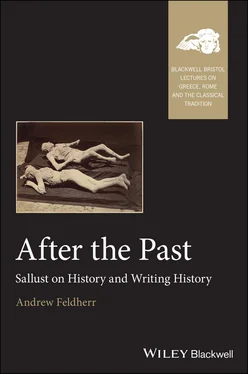Not only does the abundance of archaism in Sallust’s diction and orthography give temporal depth to his diction, but he can exploit formal similarities and etymology to amplify the power of words to signify the processes of history. An example comes at a crucial moment in Rome’s moral history that also has profound semantic consequences, the advent of ambitio :
Sed primo magis ambitio quam avaritia animos hominum exercebat, quod tamen vitium propius virtutem erat; nam gloriam honorem imperium bonus et ignavos aeque sibi exoptant, sed ille vera via nititur, huic quia bonae artes desunt, dolis atque fallaciis contendit . ( Cat . 11.1–2)
But at first ambition troubled the souls of men more than avarice because ambition was a vice nearer virtue. For glory, honor, and power are desired equally by the good man and the base, but the first strives by the true road, while the latter, because he lacks good skills, struggles by means of guile and falsehood.
As I will discuss further in the next chapter, both the twin vices Sallust portrays as inverting the moral climate in Rome after the defeat of Carthage complicate social communication, here explicitly by forcing the ambitious themselves to use deception. Yet Sallust’s language on its own reproduces that moral confusion in several ways. First, the claim that vice is nearer virtue is expressed in a phrase that, by bringing the words themselves into proximity, highlights the similarity of their forms (trisyllabic words beginning with vi - and ending with - m ). Within the next sentence, that repeated assonance points the connection between virtus and the true path ( vera via ) of the good man, as though Sallust is trying to combat ambition’s capacity to make vice look like virtue by insisting on the true difference. 36The distinction between ambition and virtue is also expressed negatively: the base man contrasts with the good because of the lack of good arts. And the suggestion of tautology that results from the repetition of bonus also becomes meaningful thanks to an etymological play embedded in bonae artes . For a common etymology of the word ars connects it to arete , the Greek word translated by virtus . 37The good man manifests virtue because he uses good arts which themselves point back to virtue. The redundancy of this argument might be legitimately taken to show the poverty and weakness of a definition of virtue that perhaps goes some way to explaining how it can be confused with ambition. On the other hand, this “virtuous circle” reveals how the language itself constructs the self-sufficiency of virtus and above all its sameness and historical consistency both as a word, echoing the beginnings of Sallust’s texts, 38and as a universal idea which can be expressed in Greek as well as in Latin. The pattern that insists that virtue is always itself again suggests similarity and difference to ambitio , whose transparent etymology describes candidates “going around” to influence votes. 39
The description of virtue’s path as true allows for a final consideration of what this passage reveals about the historiographic voice in relation to time. On the one hand, Sallust’s language reproduces the confusions that arise at the specific moment when ambition produces its confusing alternatives to virtue. The fact that those driven by ambition themselves use deliberate falsehoods constructs them within the texts as rivals to the historian’s true voice. Sallust’s language, then, is at once mimetic of a place in time, and distanced from it. To apply Grethlein’s terms, it is equally teleological and experiential. Ambition’s deceit arises in part from the voices of figures in history, who no doubt claimed virtus for themselves, but it also emerges from Sallust’s retrospective, philosophically inflected view of their behavior as virtue by other means. The morphological and etymological wordplay on the text’s surface at once reproduces the confusion that allows a vitium to masquerade as virtus and points to continuities within the text and within history that take virtus out of time. Sallust is at once revealing the truth of how it was, and of how it (always) is. 40
The semantic doubling of Sallust’s language shows simultaneously how his moral terminology has been transformed by time and how it transcends time. And I conclude this discussion of Sallustian hermeneutics with the suggestion that this quality of his language extends forward to generate a split in the contemporary scholarly interpretation of his writings between those who on the one hand tend to privilege the ideational content of his work and look beyond the textual surface to Sallust’s political thought, and those who oppose such an approach by stressing the patterns of contradictions that emerge from the play of signs themselves. It should be clear by now that, rather than endorsing one of these seemingly incompatible approaches to reading Sallust, and without ignoring how each way of reading has its own intellectual genealogy in contemporary scholarship (the one grounded in positivism, the other, often but not inevitably, in deconstruction), my aim is to suggest that both strategies of analysis also take their cue from Sallust’s enabling his readers to follow either path. I do this by juxtaposing two other recent treatments of the term whose (non)definition we have been considering, virtus . This comparison will also suggest a final way in which different conceptions of the place of historiography in history, of the temporal relationship between representation and its referent, affirm divergent strategies of reading.
In his 2006 book, Myles McDonnell makes Sallust’s use of the term the culmination of his argument about the word’s significance in Roman culture. McDonnell essentially opposes two definitions of virtus , one a traditional Roman signification for military accomplishments, the other a more abstract ethical term for excellence rooted in the Greek philosophical tradition. His understanding of “ethical” brings his interpretation very close to mine because it implicitly depends on the element of time. McDonnell reads Sallust’s text as staging the confrontation between the two definitions of virtus . In the prefaces, in authorial interjections, and sometimes in the speeches, virtus means absolute excellence, but in the narrative it has its traditional Roman sense of “manly courage.” Ultimately Sallust’s narrative reveals how the traditional understanding of virtus leads to civil war while the philosophical virtus of the prefaces becomes a “[call] for a different, more ethical kind of Roman manliness.” 41McDonnell’s analysis therefore not only itself proposes a noncontingent meaning of virtue but presumes that the text can substitute its own definition for the one the audience knows from their own experience of the world, their place in time.
Although he does not explicitly engage with McDonnell’s argument, William Batstone’s approach to Sallustian virtus , in a number of important articles, offers a striking methodological contrast. Not only does Batstone present Sallust’s moral language as inevitably affected by the kind of slippage Cato describes, while recognizing the tendentiousness of Cato’s claim to truth, but he regards such problems as fundamental to the nature of language itself rather than being the result of any civic crisis. Influenced by post-structuralist theories of language, Batstone offers an understanding of words as always contextually defined by their use in discourse. 42Where McDonnell’s argument treats language as fundamentally referential, signifying or denoting some thing, Batstone breaks that connection and puts the word first. Words’ meanings are always contested and do not exist prior to the synchronic discourse in which they appear.
Читать дальше












